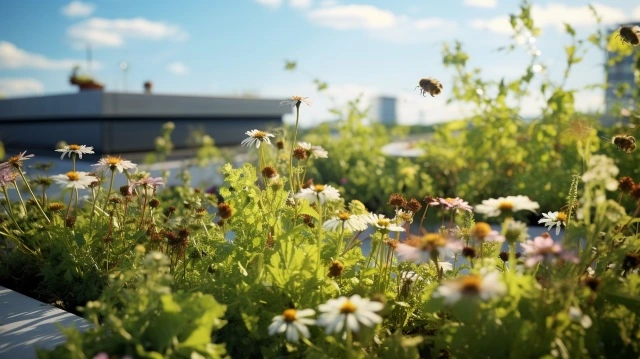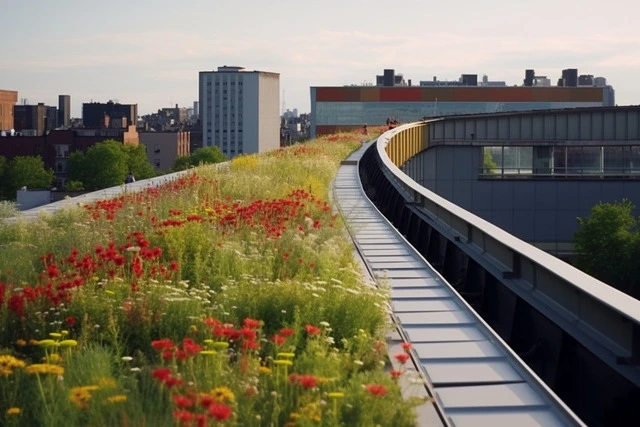By retrofitting rooftops with lush vegetation, commercial property owners can create thriving green oases that provide economic, social, and environmental benefits. As stakeholders continue to prioritize ESG principles, green roofs offer a visually striking way to showcase a commitment to the planet and the local community.
What is a green roof or rooftop?
A green roof, also known as a living roof, refers to a conventional rooftop retrofitted with a layered vegetative covering. It provides economic, social, and environmental benefits. As the commercial real estate industry continues to focus on sustainability and ESG principles, green roofs present an impactful opportunity.
How does it work?
Retrofitted with a layered vegetative covering, green rooftops use several vital components to create a living ecosystem on an otherwise unused roof. These key components include:
- Waterproof membrane: The first layer is a waterproof membrane that prevents water from seeping into the building structure.
- Root barrier: A root barrier is installed above the waterproof membrane to prevent plant roots from penetrating and damaging the roofing material.
- Drainage layer: This layer ensures excess water can easily drain away, preventing water logging on the roof.
- Growing medium: Growing mediums are specially designed soil-like substrates where plants can take root and grow. It must be lightweight to reduce the overall weight on the roof.
- Vegetation: At the top layer, selected vegetation, such as low-maintenance plants, grasses, and sometimes even small trees, grow in the growing medium to create a living ecosystem on a building’s roof.
Creating sustainable cities
Green roofs can help make cities more sustainable in a few different ways. Adding green space in urban areas counteracts the “heat island” effect of cities, cooling the surrounding air temperatures. They also reduce stormwater runoff, improve air quality, and create biodiverse habitats to support birds, butterflies, and bees.
What are some real-world examples?
High-profile companies are increasingly adopting green roofs to symbolize their commitment to sustainability. A few real-world examples of green roofs include:
- The Facebook headquarters in Menlo Park features a 9-acre green roof, the largest in the world at that scale. It also received LEED certification.
- As one of the first in the city, the Chicago City Hall’s green roof with over 20,000 plants helped encourage other buildings in the city to adopt green roofs as well.
- Currently the largest in Canada, the Vancouver Convention Centre has a six-acre green roof.
Reducing energy costs with green roofs: An investment for the future
Green rooftops improve real estate energy efficiency by providing insulation that reduces heating and cooling costs. The soil, plants, and layers of material also shield the roof from temperature swings and damage from UV exposure. These two factors contribute to the 72% reduction in heat transfer between the interior and exterior of a building
Contribute to biodiversity
Green roofs may provide the only available green space in urban city centers. This oasis allows native plants, birds, bees, and butterflies to colonize the area. Diverse native plants can attract more extraordinary biodiversity. Large enough green roofs can even keep beehives pollinating local flowers.
The impact of green roofs on air quality: A breath of fresh air
Increasing the plant population through green roofs improves the air quality in the surrounding area. The plants absorb carbon dioxide and release oxygen through photosynthesis.
Rainwater is filtered through the substrate, retaining nitrogen, phosphorus, and heavy metals. This prevents these compounds from passing into bodies of water and other local natural features.
For every 1,000 square feet of green roof space, 40 pounds of pollutants are removed from the air yearly. Forty pounds of pollutants equals the air emissions 15 vehicles produce annually.
ESG principles in Real Estate: Green Roofs in sustainable property management
Environmental, social, and governance (ESG) criteria continue to grow in value within the commercial real estate industry. Tenants and investors alike want accountability on sustainability metrics and prioritize ESG green buildings to lease or invest in. Commercial real estate companies can use green roofs to showcase all aspects of ESG.
- Environmental: To improve the ecological aspects of a building, green roofs improve air quality, manage stormwater runoff, and support biodiversity.
- Social: Green roofs showcase local communities’ social commitment by providing a community green space and increasing recreational opportunities.
- Governance: Green roofs demonstrate leadership in sustainability and make operations more resilient to climate impacts.
What difference does it make in commercial real estate?
Implementing green roofs can make a significant difference in commercial real estate buildings for owners, investors, and tenants:
- Increase property value: Green buildings command higher sale and lease prices. Tenants are drawn to sustainable features like green roofs, which can increase rent values by 20%.
- Lower stormwater fees: Green infrastructure can reduce stormwater utility fees in some cities.
- Branding and marketing: A green roof can be incorporated into a property’s brand identity and sustainability messaging. It signals progressive and high-quality management.
- Community benefits: Green space, improved air quality, and stormwater management are community perks that demonstrate corporate responsibility.
Green roofs can set properties apart as ESG principles become more important in real estate.
To help you meet ESG compliance, ProptechOS can act as an operating system for your building to connect all your smart systems and Proptech solutions. This allows you to enhance the efficiency of all your building systems.
You can forecast the value of a green roof and proactively maintain it to maximize the benefits a green roof can bring to your CRE buildings. Try ProptechOS for free today and see the difference a unified ecosystem can make in your operations.

Dr. Erik Wallin
Chief Ecosystem Officer, and founder of ProptechOS and RealEstateCore is recognized as a leader in Building Operating Systems (BOS) and making the buildings of the world smarter. He holds an MSc and a Ph.D. in Media and Computer Science from KTH Royal Institute of Technology.
Read his full bio and information here.

